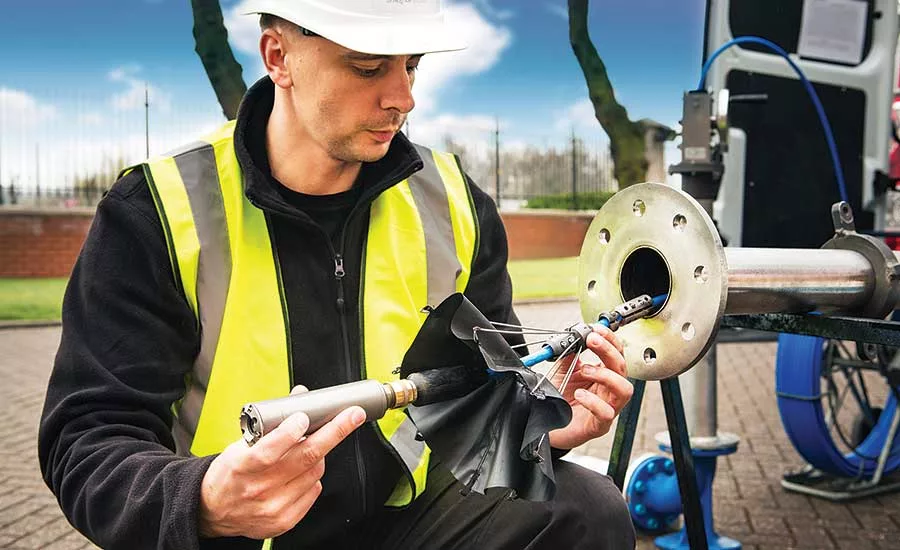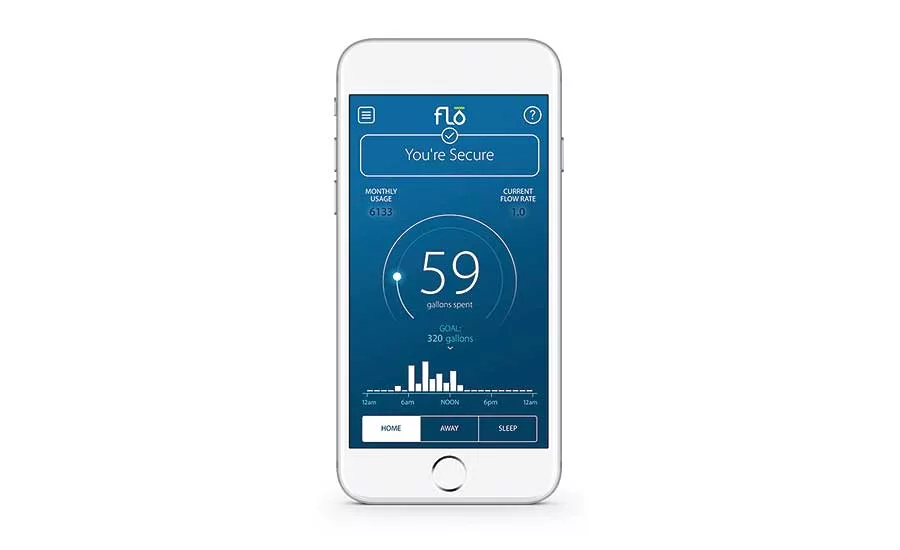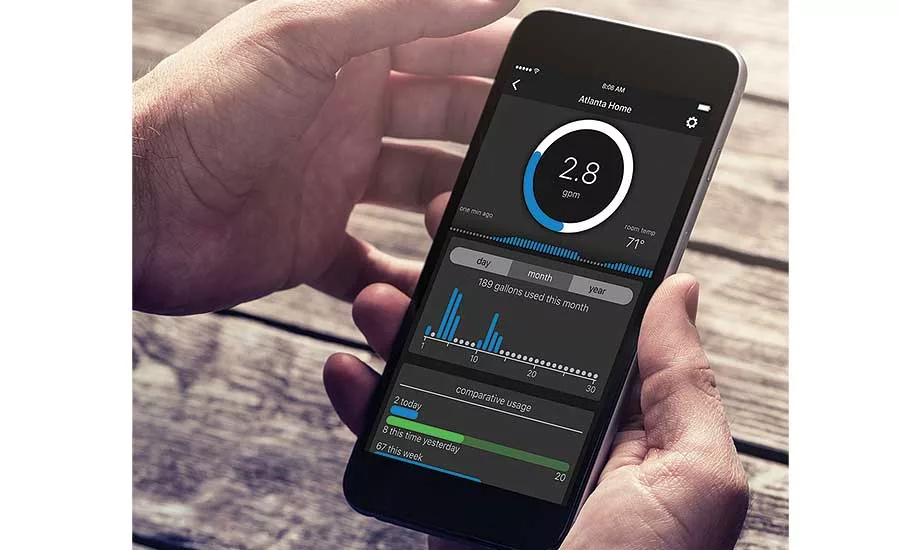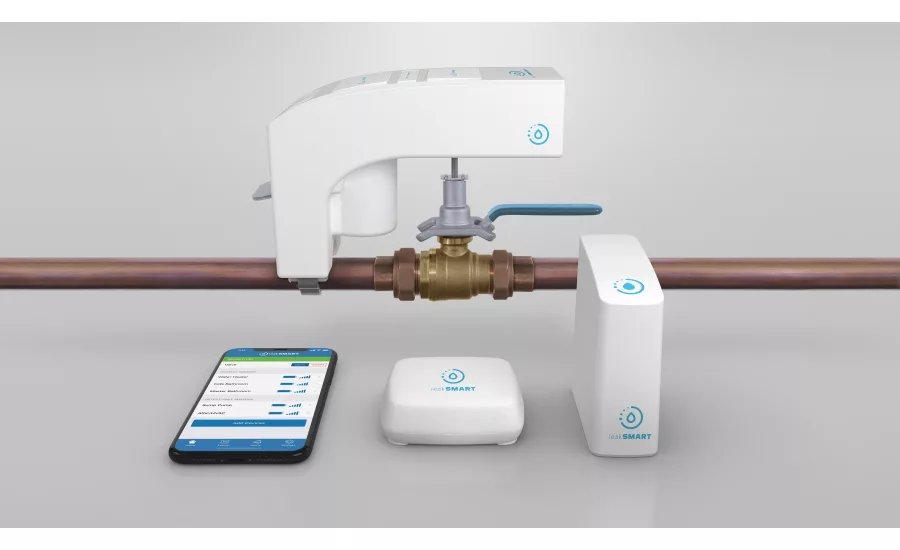The leak-detection revolution

Aquam Pipe Diangostics’ LDS 1000 Long Distance pipeline inspection technology allows for visual condition assessment and leak detection. Photo credit: Aquam Pipe Diagnostics

Flo Technologies’ mobile app provides real-time water usage and alerts and allows the user to control the device from anywhere. Photo credit: Flo Technologies

The FloLogic Leak Control System detects and automatically stops abnormal water flow before significant water damage can occur. Photo credit: FloLogic

The Streamlabs Smart Home Monitor app allows the user to track usage by the hour and compare over time. Photo credit: Streamlabs, a division of Reliance Worldwide Corporation (RWC)

LeakSmart Snap is intelligent leak and flood protection with a twist. It installs in seconds without any tools or cutting into pipes. It simply snaps onto your existing main shut-off valve. It is smart enough to program itself and turn even the toughest ball or gate valve and will send you alerts when a LeakSmart Sensor detects a leak and starts shutting off your water main in five seconds or less. With the LeakSmart Hub, the system provides 100% protection even if the Internet and power go out. Photo credit: LeakSmart
With homes in the U.S. continuing to age, and with the Internet of Things continuing to infiltrate the home services and products market, it is not surprising that leak detection has exploded in popularity this past year.
From the Consumer Electronics Show to KBIS to the AHR Expo and more, manufacturers are proudly displaying these new devices that measure water pressure, temperature, and flow rate; shut off water to the home in the event of a catastrophic leak; and even remotely alert the homeowner to leaks of any and all sizes. Outside the home, detection of leaks in underground piping has also improved drastically in recent years.
Article Index:
The result of this revolution in leak-detection technology is a new breed of intelligent devices that are not just readily available to the contractors who have the knowledge and skills to install them, but also extremely appealing to tech-savvy homeowners — and, in some cases, insurance and utility companies, too.
Filling a need
Almost everyone knows someone or has heard of someone who’s had a catastrophic leak event in their home, Streamlabs Director of Marketing and Operations Jeff Long says.
“Leak detection is still an emerging market, but there is clearly a need for a whole-home water-monitoring solution,” he says. “The market has been asking for a whole-home leak-detection solution that is affordable, easy to install, and provides real-time information to homeowners.”
“The price of water has risen 41% since 2010 in the U.S, 62% of Americans feel that access to clean water is an issue, and 42% say they will be affected by water shortage in the next 10 years,” Uponor Senior Manager – Single Family Segment Kate Olinger says. “The use of smart devices to monitor and control a home’s water usage are quickly increasing, as well.”
Aquam Pipe Diagnostics Vice President Emma Quail also says the increasing price of water is helping increase awareness of leak-detection devices.
“And now with smart, time-of-use [ToU] water meters, consumers can track their water usage from customer portals as well as set up alerts to notify them of any unusual activity,” she says. “Utilities are motivated to help identify and reduce leakages and non-revenue water.”
Awareness of the leak-detection category is increasing more rapidly than ever as more homes add Internet of Things devices, insurers drive their customers to take preventive measures, and plumbers begin to sell the category with more knowledge and confidence, FloLogic Marketing Director Ian Greene says.
“Consumer awareness is also being driven by more products entering the market,” he adds.
“We live in an era of smart homes," said Jeff Pratt, vice president of sales – North America at LeakSmart. "But what if we had smarter homes — those that not only warn us of problems, but do something to stop those problems in their tracks before damage can be done? Luckily, the future is now. Plumbing professionals can offer homeowners peace of mind with a product that offers 100% protection anytime anywhere.”
Environmental concerns are also driving adoption of these smart leak-detection devices.
“The EPA estimates that 13% of water that goes into the home is lost due to leaks,” Flo Technologies CEO and co-founder Gabriel Halimi says. “That’s a trillion gallons a year — 18 gallons of water per home, per day. The fact we can certify a home as leak-free and promote maintenance of that home helps the homeowner save money.”
Detecting leaks early
Leaks can be found a few different ways. Some devices use sensors, or pucks, to detect moisture; some monitor water line pressure, temperature and flow rate; and others help a plumber listen or even visually inspect for potential leaks.
In the past, however, leaks have traditionally been detected and reported by homeowners who either receive a high water bill or observe the leak themselves.
“At this point, a homeowner has already suffered damage to his or her home — and wallet — before [the leak is detected],” Olinger says. “Early leak detection can reduce the amount of damage before the problem becomes more destructive.”
Uponor’s Phyn Plus installs on a home’s main plumbing line and has a shut-off valve.
“It monitors pressure, flow and temperature to detect all types of leaks,” Olinger says. “It also features patented machine learning algorithms to detect water usage and notify homeowners of abnormalities.”
Flo is also installed on the main water supply line and “catches not only all the leaks in the home and shuts off the water, but really identifies the vulnerabilities that exist in the plumbing system that promote maintenance of the plumbing system rather than just alert to some catastrophic event,” Halimi says. “We include inside the Flo device a pressure/temperature and flow sensor, and we’re collecting data on what’s happening in the water system every second of the day.”
FloLogic is a flow-based system that constantly monitors for leaks of all sizes and automatically shuts off the water upon detection of a problem.
“When plumbers install flow-based leak detection with auto shutoff, the technology will detect and stop the leaks and the property owners often call in the plumber to fix leaks that need professional attention,” Greene says. “FloLogic’s flow sensor [is] constantly sensing and automatically stopping leaks as small as half an ounce per minute. Once a leak is flagged, if its location isn’t obvious, specialized acoustic-based technologies allow plumbers and leak detection, specialists to pinpoint hidden leaks, such as those lurking behind a wall, below ground or under a slab.”
“At Aquam Pipe Diagnostics, we employ a wide range of state-of-the-art equipment and processes for pressurized and non-pressurized pipe inspection and leak detection including non-destructive assessment, CCTV technology with ultrasonic transducers, and hydrophones,” Quail says. “For potable water pipelines, we combine live-feed CCTV, ultra-sensitive hydrophone technology and a high-powered sonde to pinpoint areas of potential leaks using a variety of delivery mechanisms tailored to each situation.”
Leaks can occur anywhere, anytime, in the home due to environmental factors like weather or lifetime and aging of plumbing materials in pipe, fittings and valves, Long says.
“Invasive solutions require cutting off water service and rough-plumbing a monitoring device into a supply line,” he says. “Non-invasive solutions such as the Streamlabs Smart Home Water Monitor require no pipe cutting and can be installed without disruption to water service.”
Opportunity for contractors
Since most of these new leak-detection devices require installation by a plumber, there is an emerging opportunity for contractors to embrace these technologies and reap the benefits.
“We’re really bridging the relationship and building a closer tie between homeowners and service professionals,” Halimi says. “This is very much the future of plumbing — adopting these types of IoT solutions.”
Promoting leak-detection technology delivers a multitude of benefits to contractors’ bottom lines, Greene agrees.
“Selling and installing the product provides sales margins and labor revenue that can rival or eclipse that of items like water heaters,” he says. “Installing leak-detection valves is not much different than installing a standard shutoff valve. The homeowner can easily configure the Wi-Fi and app setup and can grant the contractor user access ranging from notification-receipt only up to full device control.”
Offering leak-detection services gives plumbing contractors an opportunity to grow and expand their businesses to a broader audience, Olinger says.
“It allows them to go to a home and have a solution when the homeowner asks how they can prevent this from happening next time. It can also allow contractors to build or expand a service business, allowing them to have some steady and consistent income from installing these devices.”
Aquam Pipe Diagnostics Sales Manager Jim Fisher says the profit margin for contractors is not insignificant.
“The costs for some types of sensors have dropped by more than half compared to years past. This makes it much more attainable for one- or two-man contractor firms to enter the market with relatively sophisticated solutions and provide leak detection as part of their offerings.
“While the costs have decreased, the technology is still complex, so training is essential,” Fisher continues. “At Aquam Pipe Diagnostics, we offer in-depth, hands-on, real-world training on our full range of pipeline assessment and inspection technologies.”
Contractors can also take advantage of insurance companies that are becoming more proactive about recommending leak-detection technology to help prevent insurance claims, Greene says.
“Data from the Insurance Information Institute indicates plumbing leaks result in more than $10 billion in claims payouts each year, so it’s logical for insurers to advocate technology that mitigates these costs,” he says. “And as our climate changes, certain parts of the world have severe water shortages — a problem that’s only going to get worse. In markets with water scarcity, demand for solutions to prevent waste continues to grow.”
A young market
Smart leak-detection devices have burst into the market in a big way and are here to stay. But such a fast-growing and technologically inclined market is sure to experience many changes in the coming years.
“From a study done by Park Associates in 2016, annual sales of smart water leak detectors in North America are forecast to increase from a little over 3 million units in 2016 to 5.6 million units by 2020 for a CAGR of 12%,” Olinger says. “Revenue in the same period will grow from $173 million to $233 million by 2020.”
“The next big step for the leak-detection market is for an early majority of consumers to embrace installing devices to protect their property and prevent waste,” Greene says. “The confluence of a booming Internet of Things marketplace, the availability of connected leak-control devices, and greater incentives from insurers to install water loss mitigation will drive exponential growth. In the future, we expect to see more builders offering this technology as part of their smart homes that emphasize both convenience as well as resource efficiency for the owners.”
One trillion gallons of water are wasted in North America each year, Olinger says.
“The question for the plumbing industry is going to be: How do we incorporate leak-detection systems into more and more homes each year? And, how does this translate into building fewer water-treatment plants and wells because we have ‘saved’ so much lost water?”
“The IoT has forced us to look at existing markets and ask ourselves, how can we innovate, how can we change?” Long says. “With what Streamlabs is calling the ‘Internet of Water’ — the merging of our rough plumbing experience and fusion of IoT — homeowners now have an inside look behind their walls and into their plumbing system for the first time. That’s something that, before now, was only available on a month-by-month basis when you received your water bill.”
“It’s a very exciting time to be in this space,” Halimi says. “We’re excited about what all these products are going to do to create better user experiences and safer homes.”
This article was originally titled “The leak-detection revolution” in the April 2018 print edition of Plumbing & Mechanical.
Looking for a reprint of this article?
From high-res PDFs to custom plaques, order your copy today!








